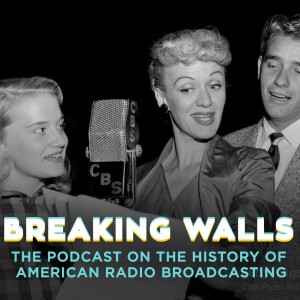
BW - EP148—004: February 1944 With Bob Hope—The Bob Hope Show With Guest Ginger Rogers 2/8/1944
 2024-02-01
2024-02-01
Download
Right click and do "save link as"
On Tuesday February 8th, 1944 at 10 PM eastern time over WEAF, and at 7PM pacific time over KFI, Bob Hope’s Pepsodent Program signed on live, coast-to-coast from Oceanside, California.
The guest was Ginger Rogers, the program features a salute to her new film, Lady In The Dark.
It was radio’s top show, pulling a rating that month of 36.2. Nearly twenty-eight million people heard this show, which is even more impressive when you consider how many were overseas fighting World War II.
Hope’s top sidekick was Jerry Colonna, perhaps the wildest comic presence on 1940s radio. Colonna had once been a serious trombonist, playing with Goodman, Shaw, and the Dorseys: now he infused Hope’s program with verbal and vocal mayhem. He sported a four-inch walrus mustache and had a comedy style that blew away any attempt at logic.
As soon as Colonna began walking to the microphone, the studio audience warned listeners with laughter.” Hope later wrote, there were two sides to Colonna’s persona: “One is the zany, silly moron, and the other is the deep thinking, serious moron.”
His songstress was the immensely talented Frances Langford, equally adept at both comedy and drama.
But, Hope was the star. As the late John Dunning once said, No one had ever told jokes quite like Bob Hope. His monologues were rapid-fire blasts of comedy, extremely topical and wildly appreciated by his live audience.
Radio Life wrote, “Hope tells a gag in three lines. He’ll work for an hour on a one-word change. By the time he goes on the air, he knows his gags by heart.” He employed a team of twelve writers in three, two-man teams. Each were assigned to write the show’s three sections. First came the monologue; then a midshow routine with Colonna or another member of the regular cast; and finally, a sketch for the guest star.
It was a true test of endurance. Hope demanded long rehearsals, including a sixty-minute runthrough with a live audience. He’d stand at the microphone, highlighting his script where the big laughs came. When you consider that Hope’s weekly audience was more than each of the first two Super Bowls, it’s easier to understand his point of view.
The biggest problem with Hope, said producer Al Capstaff in 1945, was his inevitable tendency to pack the script. It was always thirty-seven minutes long and had to be whittled down joke by joke until only the surefire material remained. The result on the air was a breathless gush, with six laughs a minute guaranteed.
But, that was Hope. Even in his 1972 Dick Cavett interview which has been featured throughout this episode of Breaking Walls, an off-the-cuff Hope can’t help but pack one-liner after one-liner in the midst of a genuine, serious, conversation.
The Pepsodent Program was enhanced by Hope’s film career. By February of 1944 Hope had starred in seventeen films since the release of The Big Broadcast of 1938, including the first three Road To films with Bing Crosby.
view more
More Episodes
012345678910111213141516171819
Create your
podcast in
minutes
- Full-featured podcast site
- Unlimited storage and bandwidth
- Comprehensive podcast stats
- Distribute to Apple Podcasts, Spotify, and more
- Make money with your podcast
It is Free
- Privacy Policy
- Cookie Policy
- Terms of Use
- Consent Preferences
- Copyright © 2015-2024 Podbean.com






